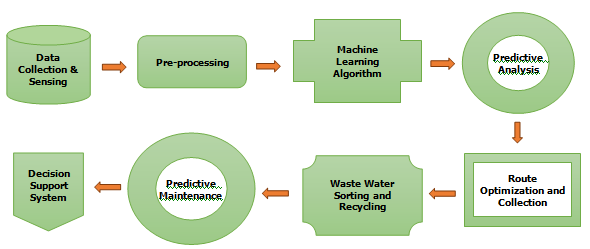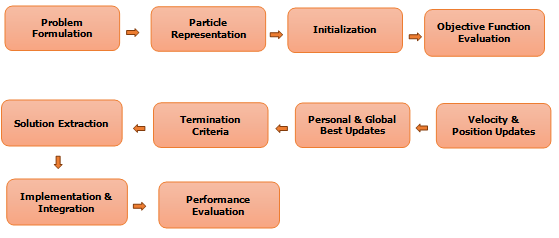Particle Swarm Optimization for AI Based Predictive Waste Management: Revolutionizing Sustainability and Efficiency
Written by A. Gandhimathinathan
Exploring the transformative potential of Artificial Intelligence (AI) in revolutionizing waste management systems for enhanced sustainability, resource efficiency, and environmental preservation, this study delves into the innovative applications of AI technologies in waste collection, sorting, recycling, and overall waste optimization. Furthermore, it also highlights the pressing challenges posed by mounting waste generation, limited landfill space, and environmental pollution. This article emphasizes the urgent need for smarter waste management solutions to mitigate the adverse impacts on the planet and on human health. To address this, we introduce AI's significant contributions to waste collection. AI-driven systems enable real-time data analysis from sensors and smart bins, predicting waste levels and optimizing collection routes. This dynamic approach reduces fuel consumption, minimizes carbon emissions, and enhances overall waste collection efficiency.
Furthermore, this article explores AI's role in waste sorting and recycling-- a crucial aspect of sustainable waste management. Advanced AI algorithms can accurately predict and separate recyclable materials from mixed waste streams, increasing recycling rates and reducing the burden on landfills. By leveraging Particle Swarm Optimization (PSO)’s ability to search for the optimal solution in a multi-dimensional space, waste management systems can be fine-tuned to achieve higher accuracy, efficiency, and sustainability. However, it’s essential to carefully design the fitness function and define the optimization problem to ensure that PSO converges to meaningful and practical solutions. The application of AI in recycling centers enhances material recovery and promotes a circular economy by facilitating the reuse of valuable resources.
Introduction
In recent years, the world has witnessed an alarming rise in waste generation, presenting formidable challenges to environmental sustainability and resource management [1]. Conventional waste management systems are often inefficient and struggle to cope with ever-growing waste streams. However, with the emergence of Artificial Intelligence (AI) technologies, there is newfound hope in revolutionizing waste management practices to tackle these pressing issues [2].
AI, with its ability to process vast amounts of data and learn from patterns, offers innovative solutions to optimize waste collection, sorting, recycling, and overall waste disposal processes. This technology promises to transform the traditional linear waste management model into a circular and resource-efficient system, driving progress towards a more sustainable future [3]-[4].
This paper explores the profound impact of AI-based waste management, delving into the diverse applications and advantages it brings to the field of sustainability and environmental preservation. From predicting waste generation patterns to enabling real-time optimization of waste collection routes, AI holds the potential to significantly enhance operational efficiency while minimizing environmental impacts.
In this study, we delve into the various aspects of AI-based waste management, examining its contributions to recycling rates, landfill management, and the promotion of a circular economy. We also address the challenges and considerations involved in the responsible deployment of AI technologies, ensuring equitable access and privacy protection.
As we navigate the path towards a greener and more sustainable future, the integration of AI into waste management stands as a promising beacon of hope. Through this research, we aim to shed light on the transformative power of AI in revolutionizing waste management practices, ultimately fostering a cleaner, healthier, and more resilient environment for generations to come.
Frame Work for AI-Based Predictive Waste Management
- Data Collection and Sensing: In the first block, data collection and sensing systems are deployed to gather real-time information on waste generation, composition, and fill levels. These systems may include sensors in waste bins, smart city infrastructure, and waste collection vehicles, providing continuous data streams.
- Data Preprocessing and Integration: The collected data is preprocessed to clean, aggregate, and integrate diverse data sources. This block ensures that the data is standardized and compatible for further analysis, eliminating inconsistencies and improving data quality.
- Machine Learning Algorithms: In this block, advanced machine learning algorithms are employed to analyze the integrated data. These algorithms can range from regression models for waste generation prediction to classification models for waste sorting and identification. AI models learn from historical data to make accurate predictions and optimize waste management strategies.
- Predictive Analysis: Using the output from the machine learning algorithms, this block generates predictive insights about waste generation patterns, fill levels of waste bins, and recycling rates. Predictive analysis enables waste management authorities to forecast waste volumes and optimize waste collection schedules and routes.
- Route Optimization and Collection: With the help of predictive insights, this block optimizes waste collection routes in real-time. AI algorithms dynamically adjust collection routes based on current waste fill levels, traffic conditions, and environmental factors. This ensures efficient waste collection, minimizing fuel consumption, and reducing greenhouse gas emissions.
- Waste Sorting and Recycling: AI-powered waste sorting systems are integrated into this block. These systems use computer vision and machine learning to identify and separate different types of waste materials, such as plastics, metals, glass, and paper. The sorted materials can then be sent to recycling facilities, contributing to a circular economy.
- Predictive Maintenance: This block employs AI to monitor the condition of waste management equipment and vehicles. AI algorithms predict maintenance requirements, allowing for proactive maintenance and reducing downtime. Predictive maintenance ensures the efficient functioning of waste management infrastructure.
- Decision Support System: The final block incorporates the predictive insights into a decision support system. Waste management authorities and policymakers can use this system to make data-driven decisions on resource allocation, waste management strategies, and policy implementation.
By combining AI-based predictive analysis with smart waste management technologies, this framework revolutionizes sustainability and efficiency in waste management. It enables waste management authorities to optimize waste collection, recycling, and landfill management, leading to reduced environmental impact and enhanced resource conservation. The integration of AI in waste management paves the way for a greener, more sustainable future, where waste is viewed as a valuable resource in the circular economy paradigm. The framework for the proposed PSO for AI based predictive waste management is depicted in Figure 1.
Figure 1: Framework for the Proposed PSO for AI based Predictive Waste Management Methodology.
The methodology of the proposed system is shown in Figure 2.
Figure 2: Methodology of the Proposed System
The methodology of Particle Swarm Optimization (PSO) for AI-based Predictive Waste Management involves several steps to optimize various aspects of waste management. Here's a high-level outline of the methodology:
- Problem Formulation: Define the specific objectives and optimization problems related to predictive waste management. This could include optimizing waste collection routes, waste sorting, recycling rates, bin placement, predictive maintenance, or resource allocation. Clearly define the optimization variables, constraints, and the objective function to be optimized.
- Particle Representation: Represent each particle in the PSO as a potential solution to the waste management problem. Depending on the specific application, the particles may represent routes, bin locations, maintenance schedules, or resource allocations.
- Initialization: Randomly initialize a swarm of particles within the feasible search space. The initial positions and velocities of the particles are set randomly, ensuring they satisfy any constraints defined by the problem.
- Objective Function Evaluation: Evaluate the fitness (objective function value) of each particle based on its position in the search space. The objective function represents the performance measure of the particle's solution, such as the total travel distance for waste collection routes or the recycling rate achieved.
- Velocity and Position Update: Update the velocity and position of each particle using the PSO algorithm's velocity and position update equations. The update involves considering the particle's best-known position (personal best) and the best position found by the swarm (global best).
- Personal and Global Best Update: Compare the fitness of each particle's current position with its personal best and the global best fitness achieved by the entire swarm. Update the personal and global best positions accordingly.
- Termination Criteria: Set termination criteria for the PSO algorithm, such as the maximum number of iterations or reaching a satisfactory solution. If the termination criteria are not met, repeat steps 4 to 6 until the criteria are satisfied.
- Solution Extraction: Once the PSO algorithm converges or the termination criteria are met, extract the best solution found by the swarm. This solution represents the optimized solution to the predictive waste management problem.
- Implementation and Integration: Implement the optimized solution into the waste management system. This could involve updating waste collection routes, bin placements, maintenance schedules, or resource allocations based on the results obtained from PSO.
- Performance Evaluation: Evaluate the performance of the optimized solution in the real-world waste management system. Monitor the improvements in efficiency, recycling rates, cost-effectiveness, and other relevant metrics.
The iterative nature of PSO allows it to explore the search space efficiently and find optimal or near-optimal solutions for predictive waste management problems. By integrating PSO into AI-based waste management systems, sustainable and efficient waste management practices can be realized, contributing to a cleaner environment and resource conservation.
Conclusion
In conclusion, Particle Swarm Optimization (PSO) proves to be a highly effective and versatile optimization technique for AI-Based Predictive Waste Management. Through its iterative search and optimization process, PSO efficiently explores complex solution spaces, enabling the identification of optimal or near-optimal solutions to various waste management challenges.
PSO's application in waste management has demonstrated remarkable results in several key areas:
- Waste Collection Route Optimization: PSO helps optimize waste collection routes, minimizing travel distances, and reducing fuel consumption, leading to cost savings and lower carbon emissions.
- Bin Placement and Siting: By determining the optimal locations for waste bins, PSO ensures efficient waste collection and prevents overflowing, improving overall waste management efficiency.
- Waste Sorting and Recycling: PSO optimizes the allocation of waste materials to recycling facilities, maximizing recycling rates and reducing the burden on landfills, promoting a circular economy.
- Predictive Maintenance: Through predictive maintenance schedules, PSO minimizes equipment downtime, ensuring smooth waste management operations and minimizing service disruptions.
- Resource Allocation: PSO assists in efficiently allocating waste management resources, such as collection trucks and personnel, based on demand and optimizing resource utilization.
The synergy between PSO and AI technologies empowers predictive waste management systems with enhanced accuracy and efficiency. The optimization of waste management processes through PSO leads to cost-effectiveness, sustainability, and reduced environmental impact.
However, it is essential to recognize that the success of PSO in predictive waste management relies heavily on the quality and quantity of data available. Accurate and comprehensive data collection is crucial to enable the algorithm to converge to meaningful and practical solutions.
In summary, PSO offers a promising approach to address the complexities of AI-Based Predictive Waste Management, helping to revolutionize waste collection, recycling, and resource allocation processes. By embracing PSO in waste management practices, communities can work towards a cleaner and more sustainable environment while maximizing resource efficiency and mitigating environmental impacts. As research and technology continue to evolve, the integration of PSO in AI-based waste management systems holds great promise for a greener and more resilient future.
References
- Mookkaiah, Senthil Sivakumar, Gurumekala Thangavelu, Rahul Hebbar, Nipun Haldar, and Hargovind Singh (2022). Design and development of smart Internet of Things–based solid waste management system using computer vision. Environmental Science and Pollution Research, 29(43), 64871-64885.
- Sallang, Nicholas Chieng Anak, Mohammad Tariqul Islam, Mohammad Shahidul Islam, and Haslina Arshad (2021). A CNN-Based Smart Waste Management System Using TensorFlow Lite and LoRa-GPS Shield in Internet of Things Environment. IEEE Access 9, 153560-153574.
- Sheng, Teoh Ji, Mohammad Shahidul Islam, Norbahiah Misran, Mohd Hafiz Baharuddin, Haslina Arshad, Md Rashedul Islam, Muhammad EH Chowdhury, Hatem Rmili, and Mohammad Tariqul Islam (2020). An internet of things based smart waste management system using LoRa and tensorflow deep learning model. IEEE Access 8, 148793-148811.
- Jadli, Aissam, and Mustapha Hain (2020). Toward a deep smart waste management system based on pattern recognition and transfer learning. In 2020 3rd International Conference on Advanced Communication Technologies and Networking (CommNet), pp. 1-5. IEEE.
Keywords: Energy Efficiency, Smart Waste, Particle Swarm optimization and Predictive Analysis.
To view all articles in this issue, please go to September 2023 eNewsletter. For a downloadable copy, please visit the IEEE Smart Cities Resource Center.

To have the eNewsletter delivered monthly to your inbox, join the IEEE Smart Cities Community.
Past Issues
To view archived articles, and issues, which deliver rich insight into the forces shaping the future of the smart cities. Older eNewsletter can be found here. To download full issues, visit the publications section of the IEEE Smart Cities Resource Center.





